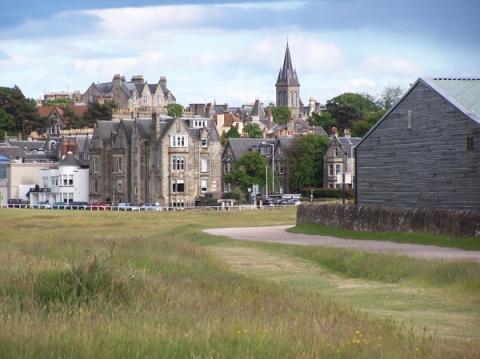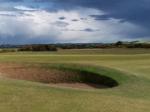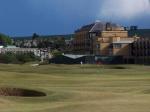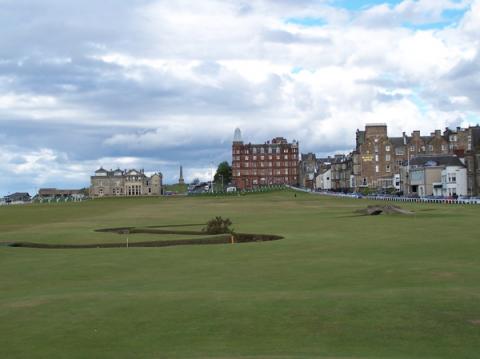
The drive over the Old Course Hotel at #17 is a knee-knocker, but the sense of achievement once you clear the shed is worth the sweat.
One visitor to this space from Denmark wrote me the following the other day about his own experience playing the St. Andrews Old Course for the first time:
On the back nine I had developed a so severe case of the shanks that I did not dare aim for the 18th green in fright of hitting one of the expensive cars parked alongside the fairway. It took almost a year to get rid of the shanks and lots of hours on the range. I will never forget the embarrassment. I cannot say that I enjoyed the round...
My own first-round intimidation at the Old Course last Saturday was at the very beginning of the round. From watching the televised Open Championship (what we Yanks refer to as The British Open) and from reports of those who had played it, I knew the fairway on the first hole was wide. But nothing can prepare you for just how much room you have -- two enormous fairways with no rough to speak of between them, and a fence so far right as to make it superfluous. If you aim down the left side of the first fairway, it is impossible to hit the ball out of play on the first at the Old Course.
Well, almost impossible. I ripped my initial drive hard left off the tee yesterday and watched it roll and roll on the hard turf toward the famous Swilken Bridge in front of the 18th tee. Friction finally took hold and the ball
I was just about to right the ship when summer changed to winter in a matter of minutes, another thing you take for granted and even wish for at St. Andrews so that you can experience the wind and rain that is as much local custom as kilts and haggis. But just two holes of pouring rain were enough "real" experience for me. By the time sunshine had returned, I was done in, a 10 handicap carding a sloppy and unforgivable 44 on the first nine (and that with a 20-foot putt that fell for birdie on #9).
But the Old Course giveth as well as taketh away, and one 60-yard six-iron roller from off the 12th green to two feet (for birdie) set me right. I began channeling Kel Nagle, the Aussie who surprised everyone, including himself, in 1960 by defeating Arnold Palmer. On the famous Road Hole, #17, I hit my best drive of the day straight over the middle of the Old Course Hotel shed, then nailed a five-iron to three feet, prompting my young caddie to announce it as one of the best approach shots he had seen there; discreetly, he did not add "...by a
 guy who shot 44 on the front." (I gave him a generous tip later for his discretion.) In shock, I made the putt for birdie on the Road Hole, followed it with a good two-putt par in the shadow of the members' clubhouse at the 18th, and carded the most memorable 83 of my life. I racked up three birdies overall for the day (and just five pars) and bore proud witness to my son Tim's even par round of 72, with three birdies himself.
guy who shot 44 on the front." (I gave him a generous tip later for his discretion.) In shock, I made the putt for birdie on the Road Hole, followed it with a good two-putt par in the shadow of the members' clubhouse at the 18th, and carded the most memorable 83 of my life. I racked up three birdies overall for the day (and just five pars) and bore proud witness to my son Tim's even par round of 72, with three birdies himself.It is hard to judge the Old Course the way you might any other great golf course, such is the aura and history of the place. I don't have much to compare it with in terms of truly "great" golf courses I have played. The Old is not as tough as Pine Valley, which is an exhausting experience that presents trouble on virtually every shot, no let-up whatsoever. St. Andrews gives you a breather now and then but a few misplaced drives might very well cause you to play sideways, or even backwards, out of one of its many sod-faced bunkers. The medicine you have to take on the Old Course can be more bitter than anywhere else because, at just 6,300 firm yards, every green is easily approachable if your aim is true off the tee box. But sometimes even the well-struck drive hits a mound and bounds into a deep jail. I was lucky and found sand only twice, both times at greenside, and was able to play forward although with no opportunity to get close to the hole. The backsides of those greenside bunkers slope down to the putting surfaces, leaving no good way to get close to most holes.
The Old Course cannot be compared to any great course that has some length to it. You play a different game at the Old than, say, at Shinnecock Hills, a relentlessly long and windblown track. Although the wind plays a vital role in strategy at both courses, a winning stroke at Shinnecock is likely to be a blast - think Corey Pavin's sparkling 4-wood on the 18th to win the U.S. Open in 1995 - whereas the winning stroke at The (British) Open Championship is likely to be a 40-yard putt at the Old Course finishing hole.
Pinehurst #2 and the Old Course share an emphasis on the short game, the severely rolling greens providing a number of options - putter, six-iron, lob wedge - from 20 yards off the putting surfaces. I chose putter for anything within 60 yards unless there was a hazard in my way. It was exhilarating to be able to use the flat stick in ways most U.S. courses never permit. My putting from 20 feet seemed to improve as I bore down on those 60-yarders, and the most memorable shots at the Old Course - and indeed of my week of links golf - were the putts and mid-iron chips from well off the greens.
In degree of difficulty, I would put St. Andrews at the Augusta National level, meaning for us normal golfers - i.e. not the pros for whom 450 yard par 4s are short - a good score is possible if you think strategically and stay out of trouble. St. Andrews and Augusta are all about patience and positioning. Greed kills at either place. The Old Course's greens are certainly firmer than Augusta's, but the Georgia course's putting speeds are way faster.
Although you pay mightily for the privilege of playing the Old Course - about $300 per round at the current dollar exchange rate - The Links Trust, which runs the courses of St. Andrews, does its best to pile on the extra bits. A nicely annotated yardage book comes along with the scorecard after payment of your green fees, as
 does a little "commemorative tin" which holds tees, ball marker and divot tool. A cheery gentleman wearing what appears to be a misshapen stovepipe hat greets you on the first tee, welcomes you to the course, and offers to take your group's photo (I took him up on it).
does a little "commemorative tin" which holds tees, ball marker and divot tool. A cheery gentleman wearing what appears to be a misshapen stovepipe hat greets you on the first tee, welcomes you to the course, and offers to take your group's photo (I took him up on it).There were just two things that seemed a little odd and out of place at the Old Course, neither of which diminished the experience, for me at least. First, although back tees (white) are in place and add up to just a 6,700-yard layout, no non-professionals are permitted to play from there. Tim, the college golfer, was bummed out by this. The other oddity was the rest room out behind the Old Course's #9 green. The urinal was stamped with the manufacturer's name, Armitage Shanks. No course should ever plant such a seed with a name like that. Perhaps, subconsciously, that is what did in our friend from Denmark on the back nine at the Old Course.

You don't want your round to end as you stand on the 18th tee at the Old Course.



